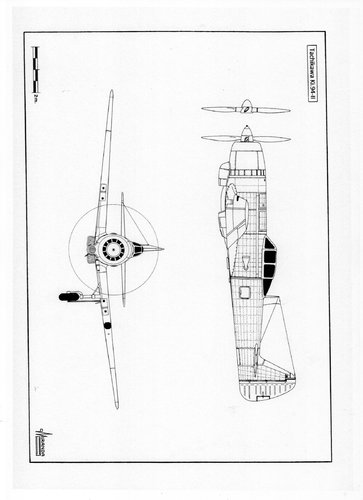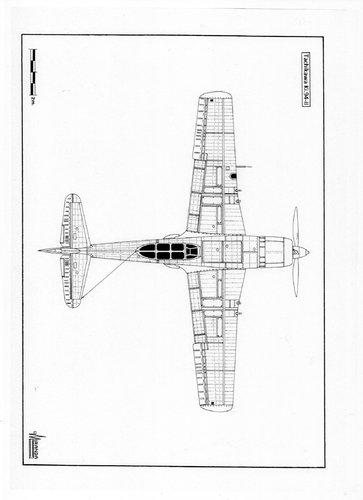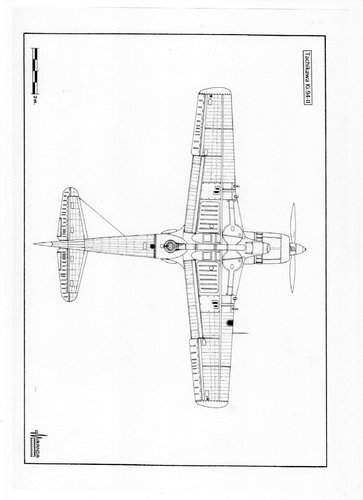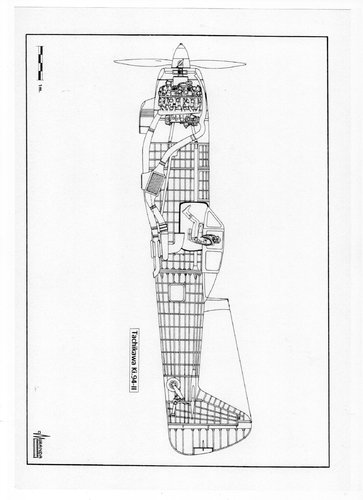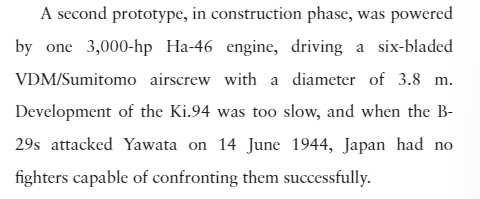You are using an out of date browser. It may not display this or other websites correctly.
You should upgrade or use an alternative browser.
You should upgrade or use an alternative browser.
Tachikawa Ki-94-Ⅱ
- Thread starter blackkite
- Start date
blackkite
Don't laugh, don't cry, don't even curse, but.....
- Joined
- 31 May 2007
- Messages
- 8,819
- Reaction score
- 7,717
The Mamoru-Kai (Ha-46) was even more problematic and Nakajima was not able to overcome the motor’s teething difficulties. Consequently, Nakajima cancelled further work on the Mamoru-Kai.
- Joined
- 19 July 2016
- Messages
- 4,279
- Reaction score
- 3,464
Great results, thank you.
Mamoru-Kai was originally envisioned for things like the Kawanishi K-100.We know that the Mamoru (14-cylinder one) was eventually replaced by Kaisei for reliability reasons, thus cancelling development on the 18-cylinder Mamoru Kai.This happened fairly early on (like 1943-44, K-100 was a 17-shi compeititor).The first prototype of the Ki-94-II didn't finish construction until august 1945, let alone the second prototype.It doesn't make sense for the japanese to fit something that didn't work and was cancelled a long time ago into one of their new state-of-the-art prototype.The same engine (ha-46), was also know to use for Ki-87-II.Considering that they are compeititors with similar performance and dimensions, there's must be some truth to it.Perhaps japanese engineers finally manage to improve upon the ha-46 late in the war ?The Mamoru-Kai (Ha-46) was even more problematic and Nakajima was not able to overcome the motor’s teething difficulties. Consequently, Nakajima cancelled further work on the Mamoru-Kai.
Last edited:
I have fallen in love with the KI-94 II! Who makes this specific kit?Another Ki-94Ⅱmodel bottom.(1/48 scale)
You can see oil cooler behind the propeller,exhaust gas duct from the engine to the turbo charger, intercoolers beside the exhaust gas duct, turbo charger and ram air intake at both side of the fuselage.
View attachment 620342」
I’ve been searching for a 1/48 scale and no luck. Where did you find it?Another Ki-94Ⅱmodel bottom.(1/48 scale)
You can see oil cooler behind the propeller,exhaust gas duct from the engine to the turbo charger, intercoolers beside the exhaust gas duct, turbo charger and ram air intake at both side of the fuselage.
View attachment 620342」
High-altitude interceptors Nakajima Ki.87 and Tachikawa Ki.94
On March 1938, the Mitsubishi A5M2 fighters fighting in China started to use mechanically driven superchargers and oxygen equipment to face the new Gloster Gladiator of the Chinese Air Force that could fly at altitude of 6,000 m.
These primitive forced induction devices, based on a French Patent Rateau of 1926, consisted of a rapidly spinning impeller powered by the engine, via a short drive shaft, that sucks in ambient air then injected it into the carburetor.
By acquiring the manufacturing license of the German engine Daimler Benz DB 601, the Japanese gained access to the Vulkan coupling technology, a supercharger fitted with continuously variable transmission device that automatically regulated the rotation speed of the impeller by means of a barometric control
The study of a Merlin XX British engine, from a Hawker Hurricane Mk.II captured in Singapore, allowed Kawasaki engineers to build their first two-stage supercharger for the Ha-140 engine. The British system used two impellers that rotated at different speeds selected by the pilot by means of a gearbox. The use of two impellers in engines of more than 1,500 hp requires the installation of an intercooler, to avoid the premature detonation problems that occur when air is injected into the carburetor at an excessive temperature.
In 1937 Japan acquired a turbocharger to the Swiss company Brown Boveri & Cie and, based on the Swiss model, the Hitachi, Nakajima and Mitsubishi engineers received the assignment to develop their own turbocharger. By the end of 1942, Mitsubishi produced the mechanically driven Ru-302 supercharger, with two-stages and two-speeds, for the Ki.46-IV high-altitude reconnaissance airplane. The Ru-302 did not perform well during the tests, conducted in May 1944 with a J2M4 Raiden-33 fighter. The Hitachi turbo was manufactured with the best available alloys of chrome-molybdenum steel, but its development was too slow and was still being tested, installed in a C6N Saiun, by the end of World War II.
The Nakajima team tried to modify an A6M2 by installing a Sakae turbocharged engine without an intercooler. The prototype was named A6M4 and started its flight test at Yokosuka Arsenal in 1943, experiencing fires and multiple ruptures in compressor and ducting. The origin of these failures was that the imported Swiss turbo was actually a design for diesel 500 hp engines with operating temperature that was 200 degrees Celsius lower than that of petrol Japanese engines. Despite all these problems, the Mitsubishi engineers managed to build the A6M3 series in 1942, powered by a Sakae 21 and able to climb up to 11,000 m thanks to a modest two-speed supercharger.
The Japanese tried to increase the power of their engines with Methanol-water and oxygen injection devices, but the system only worked below 10,000 m. Mitsubishi engineers tried to develop an exhaust-driven turbo-supercharger based on the study of North American P-43 and B-17 aircraft captured in China and Philippines. By mid-1944 turbo-superchargers were indispensable to fight the B-29 bombers at altitudes over 10,000 m, but the Japanese industry was unable to duplicate the captured airplanes.
The General Electric turbo-supercharger was a product that required enormous technical and manufacturing resources that were not available in Japan. The high temperatures reached by exhaust gas and the high rotation speeds of turbines (26,000 rpm) required the use of austenitic stainless steel chrome-molybdenum alloys and the development of work-hardening techniques that enabled the turbo-charger to withstand stresses caused by centrifugal forces. The precision machining of turbines and impellers could only be made possible by sophisticated machine tools and surplus of raw materials.
Availability of high-octane fuel let the American engines run hotter without detonation problems, but the Japanese had 87-octane only and should use forced air cooling fans to avoid the overheating of their supercharged engines.
In August 1944 the Mitsubishi J2M4 Raiden 34 flew with one Ru-303 exhaust-driven turbo-supercharger mounted in the starboard side of the fuselage, just behind the Kasei 23c engine. The new supercharger did not work properly either, provoking fires during the tests, and never became operational.
The exhaust-driven turbo-superchargers were larger, involved extra piping and increasing an aircraft size, weight, complexity and cost. It is not possible to install them in a conventional single engine fighter and it use requires airplanes specially designed, with enough room for installation of the turbo, the intercooler and the heavy tubing system.
In February 1942, the U.S. Government placed an order for 1,600 Boeing B-29 super bombers, able to fly at 595 kph and 9,700 m of altitude. In April, the Koku Hombu Technical Branch issued a specification calling for a high-altitude interceptor with 800 km/h max speed, 13,000 m service ceiling and 3,000 km range, armed with four 30 mm cannons. The specification was so demanding that most Japanese aircraft manufacturers decided not to submit projects.
In the summer of 1942, the Tachikawa firm began the design of the Ki.94-I, a twin booms heavy fighter powered by two 2,000 hp Ha-211 Ru air-cooled radial engines (mounted in push-pull configuration) driving two VDM constant-speed propellers with 3.32 m of diameter. With the use of the new Ru-302 mechanically-driven superchargers, a service ceiling of 14,000 m was expected. In October 1943, the mock-up was presented to Koku Hombu, but IA experts decided that the plane was too heavy and with an overly complex propulsion system. The project was dropped.
Ki.94-I technical data
Wingspan: 15 m, length: 13.05 m, height: 3.85 m, wing area: 37 sq. m, max speed: 780 km/h, max weight: 9,400 kg, ceiling: 14,000 m, range: 4,520 km. Proposed armament: 2x37 mm Ho-203 and 2x30 mm Ho-105 cannons.
The IJA intelligence services awaited the first B-29 attack in April 1944, but this was delayed by lack of supplies at the Chinese airfields of Kweiling and Liuchow. The first contact with the B-29 occurred in 26 April, when six Ki.43 fighters of the IJA 204th Sentai had a worrying combat with a B-29 of the 444th B.G., which was flying supplies from India to China. The giant plane, heavily loaded and with the tail gun off service, was shot 12 times without apparent results, it just ascended until the Hayabusas were forced to abandon the pursuit by lack of oxygen.
It was known that the B-29 could fly at high altitudes thanks to its turbocharged engines, but when it first appeared 10,000 m above Tokyo on a reconnaissance mission, it was flying so fast that the Ki.44 of the 47th Sentai could not reach it. By contrast, the J2M4, J2M5 and N1K5-J fighters, that had been designed to face it, had not even begun to be manufactured.
In March 1944 the IJA decided to lower the requirements for the high-altitude specification of 1942, asking the Nakajima firm to build the Ki.87-I, a high-altitude interceptor with a less heavy pressurization system than the Tachikawa pressure cabin.
Three versions of the Nakajima fighter are known: the Ki.87-I, the Ki.87-II, powered by one 3,000 hp Ha-46 engine (with Ru-303) driving a six-bladed propeller and the Nakajima 20-Shi-Ko, with Ha-44-21 engine developed for the IJN. The Ki.87-I prototype was flown in April 1945, powered by one 2,450 hp Ha-44-12 air cooled radial engine, with one Ru-303 turbo-supercharger mounted at the starboard side of the forward fuselage.
This configuration seemed safer than the ventral position installation. Mitsubishi engineers feared that the fuel contact with the turbo would cause fires. In 1942 the Chinese lost 139 P-43 fighters for this cause, due to a defect in the Fairplane cement used to seal the fuel tanks. The IJA disagreed and preferred a ventral installation, such as in the P-47 Thunderbolt, which delayed serial production of the Ki.87 until the end of the war. Nakajima preferred to devote its efforts to obtaining a high-altitude interceptor based on the Hayate airframe and yielded its pressurization technology to Tachikawa so that they could use it in the design of the Ki.94-II.
Ki.87-I technical data
Wingspan: 13.423 m, length: 11.82 m, height: 4.50 m, wing area: 26.0 sq. m, max speed: 697 km/h, max weight: 5,633 kg, ceiling: 12,855 m. Proposed armament: 2x30 mm (synchronized) Ho-155 and 2x20 mm Ho-5 cannons.
The Ki.94-II design was approved by the Koku Hombu in April 1944. An order was placed for three prototypes and eighteen pre-production aircraft. The aircraft was equipped with laminar flow wings, designed by Tatsuo Hasegawa, and one Nakajima pressurized cabin with armored windshield. The engine used was a 2,450 hp Ha-44-13 (with Ru-303, cooling fan and two intercoolers) driving a four-bladed propeller. The prototype was completed in July 1945, but it was not fly tested because the war ended.
A second prototype, in construction phase, was powered by one 3,000 hp Ha-46 engine, driving a six-bladed VDM/Sumitomo airscrew with 3.8 m of diameter. Development of the Ki.94 was too slow and when the B-29s attacked Yawata-Kyushu on 14 June 14 1944, Japan had no fighters capable of confronting them successfully.
Ki.94-II technical data
Wingspan: 13.4 m, length: 12 m, height: 4.61 m, wing area: 28 sq. m, max speed: 720 km/h, max weight: 6.427 kg, ceiling: 14,250 m, range: 2,200 km. Proposed armament: 2x30 mm Ho-155 and 2x20 mm Ho-5 cannons.
Similar threads
-
other less known japanese aircraft projects
- Started by airman
- Replies: 14
-
-
Japanese Secret Projects:Experimental Aircraft of the IJA & IJN 1939-1945
- Started by Pelzig
- Replies: 261
-
-

